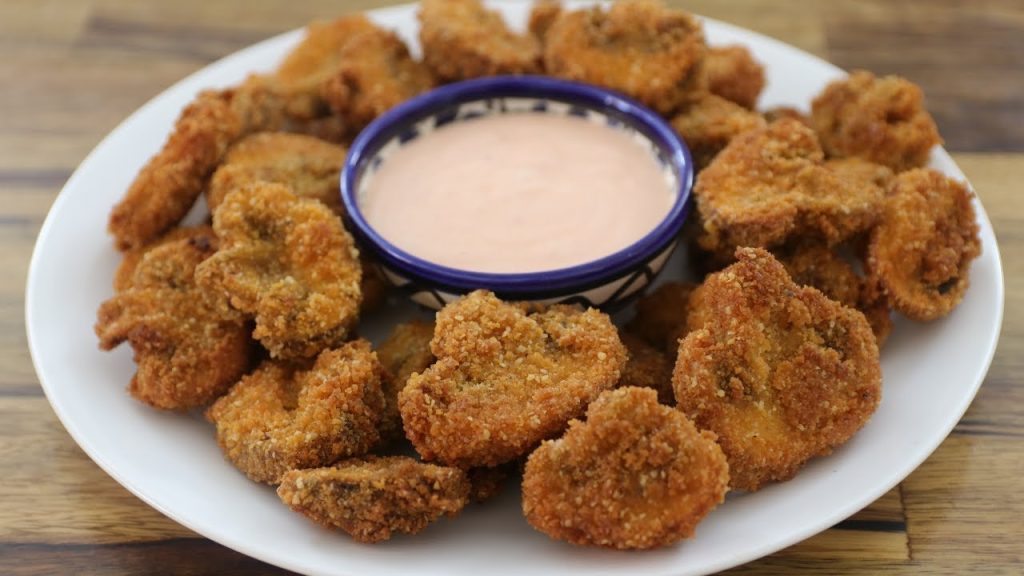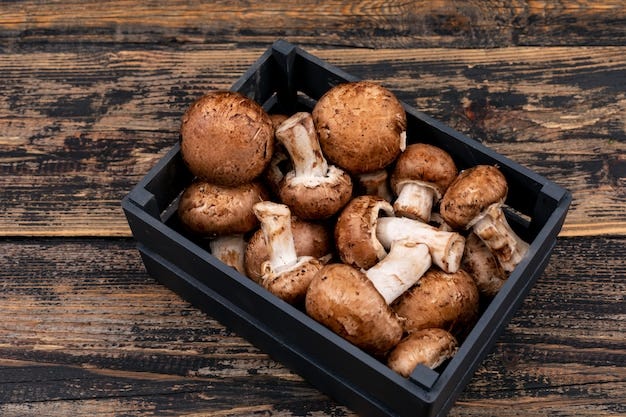The Ultimate Guide to Perfectly Fried Mushrooms

Introduction to fried mushrooms recipe
Fried mushrooms are a delightful appetizer or side dish that can elevate any meal. Their crispy exterior paired with a tender and juicy interior makes them a favorite among mushroom lovers. This comprehensive guide will walk you through the steps to achieve perfectly fried mushrooms, ensuring a delicious outcome every time.
Choosing the Right Mushrooms
The first step to perfect fried mushrooms is selecting the right variety. While many types of mushrooms can be fried, we recommend using button mushrooms, cremini mushrooms, or portobello mushrooms. These varieties have a firm texture and rich flavor that stand up well to frying.
- Button Mushrooms: These are the most common and versatile mushrooms, known for their mild flavor.
- Cremini Mushrooms: Also known as baby bellas, these mushrooms offer a deeper, earthier taste.
- Portobello Mushrooms: With their large size and meaty texture, portobellos are perfect for a heartier dish.
Preparation and Cleaning
Before frying, it’s crucial to properly clean and prepare the mushrooms. Start by gently wiping the mushrooms with a damp paper towel to remove any dirt. Avoid soaking them in water, as mushrooms are highly absorbent and can become soggy.
- Trim the Stems: Cut off the tough ends of the stems, leaving only the tender part.
- Slice or Leave Whole: Depending on your preference, you can slice the mushrooms into even pieces or leave them whole. Slicing them allows for a crispier texture, while whole mushrooms offer a juicier bite.
Battering and Seasoning
A well-seasoned batter is key to flavorful fried mushrooms. For a classic batter, you will need the following ingredients:
- All-purpose flour
- Cornstarch
- Baking powder
- Salt and pepper
- Eggs
- Milk or buttermilk
Instructions:
- Combine Dry Ingredients: In a bowl, mix the flour, cornstarch, baking powder, salt, and pepper. The cornstarch helps achieve a crispy coating, while the baking powder ensures a light and airy batter.
- Prepare Wet Mixture: In another bowl, whisk together the eggs and milk (or buttermilk). The acidity in buttermilk adds a slight tang and tenderizes the mushrooms.
- Coating Process: Dip the mushrooms into the wet mixture, allowing any excess to drip off, then coat them thoroughly in the dry mixture. For an extra crispy finish, repeat this process for a double coating.
Frying the Mushrooms
For perfectly fried mushrooms, the oil temperature and frying time are critical.
- Choose the Right Oil: Use a neutral oil with a high smoke point, such as vegetable oil, canola oil, or peanut oil. These oils can withstand high temperatures without breaking down.
- Heat the Oil: Heat the oil in a deep frying pan or pot to 350°F (175°C). Use a thermometer to maintain a consistent temperature, as overheating can burn the batter while underheating can result in greasy mushrooms.
- Fry in Batches: Fry the mushrooms in small batches to avoid overcrowding the pan, which can lower the oil temperature and cause uneven cooking. Fry for 2-3 minutes or until golden brown and crispy.
- Drain and Season: Use a slotted spoon to transfer the fried mushrooms to a plate lined with paper towels. This will absorb excess oil. Immediately season with salt to enhance the flavor.
Serving Suggestions
Fried mushrooms are incredibly versatile and can be served in various ways. Here are some serving suggestions to elevate your dish:
- As an Appetizer: Serve with dipping sauces such as ranch, garlic aioli, or a spicy sriracha mayo.
- As a Side Dish: Pair with grilled meats, roasted vegetables, or a fresh salad.
- In a Sandwich: Use fried mushrooms as a filling for sandwiches or sliders, topped with cheese and greens.
Tips for Perfect Fried Mushrooms
- Consistency in Size: Ensure all mushrooms are of similar size for even cooking.
- Temperature Control: Maintain a consistent oil temperature to avoid soggy or burnt mushrooms.
- Seasoning: Season immediately after frying for the best flavor.
Watch Video In Youtube : https://youtu.be/lbxwsYjVgZE?si=34CJn_2u0cNOkIW2
Conclusion
Fried mushrooms are a delicious and versatile dish that can be enjoyed in various settings. By following this comprehensive guide, you can achieve perfectly fried mushrooms every time. Whether as an appetizer, side dish, or main course, these crispy delights are sure to impress your guests and satisfy your cravings.
How Long Do Mushrooms Last in the Fridge? A Comprehensive Guide

Mushrooms are a versatile and nutritious addition to many dishes, but they can be tricky to store. Proper storage is essential to maintaining their freshness and preventing waste. In this article, we will explore how long mushrooms last in the fridge, the best storage practices, and tips to extend their shelf life. Whether you’re a culinary enthusiast or simply looking to reduce food waste, this guide will provide you with all the information you need to keep your mushrooms fresh and delicious.
Understanding Mushroom Shelf Life
Mushrooms, being a type of fungi, have a unique composition that makes them sensitive to moisture and temperature. When stored properly, fresh mushrooms can last in the fridge for a specific period, depending on the type and storage conditions. Generally, fresh mushrooms last between 5 to 10 days in the refrigerator. However, the exact duration can vary based on several factors, including the type of mushroom, its freshness at purchase, and the storage method used.
Types of Mushrooms and Their Shelf Life
Different types of mushrooms have varying shelf lives. Here’s a breakdown of common varieties and how long they typically last in the fridge:
- Button Mushrooms (White Mushrooms): These are among the most common mushrooms and can last for about 7 to 10 days when stored properly.
- Cremini Mushrooms: Similar to button mushrooms but with a firmer texture, cremini mushrooms have a shelf life of 5 to 7 days.
- Portobello Mushrooms: Being larger and denser, portobellos can last 4 to 7 days in the fridge.
- Shiitake Mushrooms: With their distinctive taste and texture, shiitake mushrooms can be stored for up to 7 days.
- Oyster Mushrooms: These delicate mushrooms typically last for 3 to 5 days.
- Enoki Mushrooms: Known for their long, thin stems, enoki mushrooms have a shorter shelf life, usually up to 5 days.
Best Practices for Storing Mushrooms in the Fridge
To maximize the shelf life of mushrooms, it’s crucial to store them correctly. Here are some best practices for storing mushrooms in the fridge:
1. Choose the Right Packaging
Mushrooms need to breathe, so storing them in a tightly sealed container can lead to moisture buildup and spoilage. The best way to store mushrooms is in their original packaging or in a paper bag. The paper bag absorbs excess moisture and allows for adequate air circulation, which helps keep the mushrooms fresh longer. If using a plastic container, ensure it has ventilation holes.
2. Keep the Fridge Temperature Consistent
Mushrooms are sensitive to temperature fluctuations. To keep them fresh, store them in the main compartment of the fridge rather than the crisper drawer, which can be too humid. The ideal temperature for storing mushrooms is between 32°F and 34°F (0°C to 1°C).
3. Avoid Washing Mushrooms Before Storage
Mushrooms are porous and can absorb water easily, leading to spoilage. It’s best to avoid washing mushrooms before storing them. Instead, clean them right before use by brushing off dirt or gently wiping them with a damp cloth.
4. Store Sliced or Cooked Mushrooms Properly
If you have leftover sliced or cooked mushrooms, store them in an airtight container in the fridge. Sliced mushrooms can last up to 3 days, while cooked mushrooms can last up to 5 days. Always ensure the container is properly sealed to prevent moisture loss and odor absorption from other foods.
Signs of Spoiled Mushrooms
It’s essential to know the signs of spoiled mushrooms to avoid consuming them. Here are some indicators that your mushrooms have gone bad:
- Slimy Texture: Mushrooms that have developed a slimy or sticky texture are no longer safe to eat.
- Discoloration: Fresh mushrooms should have a uniform color. If you notice dark spots, browning, or yellowing, it’s a sign of spoilage.
- Off Odor: Mushrooms should have a mild, earthy smell. A sour or pungent odor indicates that they are no longer fresh.
- Wrinkling or Shriveling: Mushrooms that appear dry, shriveled, or wrinkled are past their prime.
Extending the Shelf Life of Mushrooms
While fresh mushrooms have a limited shelf life, there are methods to extend their usability:
1. Freezing Mushrooms
Freezing is an excellent way to extend the shelf life of mushrooms. However, it’s important to note that mushrooms should be blanched before freezing. To blanch mushrooms, bring a pot of water to a boil, add the mushrooms, and cook for 1-2 minutes. Immediately transfer them to an ice bath to stop the cooking process. Once cooled, pat them dry and store them in airtight freezer bags. Properly frozen mushrooms can last up to 12 months.
2. Drying Mushrooms
Drying is another effective method to preserve mushrooms. You can use a dehydrator or oven to dry them. Slice the mushrooms thinly and place them on a drying rack. If using an oven, set it to the lowest temperature and leave the door slightly open to allow moisture to escape. Once fully dried, store the mushrooms in an airtight container in a cool, dark place. Dried mushrooms can last up to a year.
3. Pickling Mushrooms
Pickling is a flavorful way to preserve mushrooms. To pickle mushrooms, prepare a brine with vinegar, water, salt, and your choice of spices. Bring the brine to a boil, add the mushrooms, and simmer for a few minutes. Transfer the mushrooms and brine to sterilized jars and seal. Pickled mushrooms can be stored in the fridge for up to a month.
Conclusion
Understanding how long mushrooms last in the fridge and the best practices for storing them can help you make the most of this versatile ingredient. By following the tips outlined in this guide, you can extend the freshness of your mushrooms and reduce food waste. Whether you choose to store them fresh, freeze, dry, or pickle, you’ll be able to enjoy mushrooms in your dishes for a longer period.